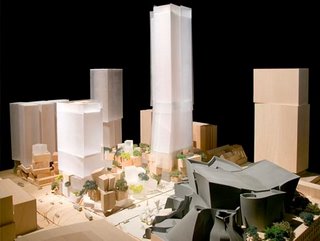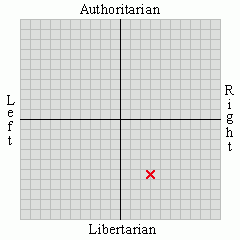 other heavy industrial forms, and embracing of curved, sweeping forms for major buildings creates a world that looks like the cartoons where Bugs Bunny visits Marvin the Martian.
other heavy industrial forms, and embracing of curved, sweeping forms for major buildings creates a world that looks like the cartoons where Bugs Bunny visits Marvin the Martian.I'm not opposed to the idea of redeveloping downtown Los Angeles; I spent a lot of time there when I worked in the insurance defense firm downtown and, in fact, during my entire time living in the Los Angeles area. Downtown L.A. kind of sucks, actually, and it could use all the help it could get. As The Wife and I will be moving back to the area shortly, it's entirely possible that we'll be visiting this area in the future. And it's likely I'll have appearances in downtown L.A. which will mean I will get to deal with all the construction that will undoubtedly be taking place up and down Temple Street. But I'm convinced that trying to get professional Angelenos to live pedestrian-friendly lives in downtown L.A. is like trying to change the direction of the wind by spitting into it.
 So what will the result of all this construction, sure to make my professional life miserable until 2016, be? Something like this.
So what will the result of all this construction, sure to make my professional life miserable until 2016, be? Something like this.The plan seems to have two main parts. First, there is what promises to be very nice greenway going from the music center, through the county building complex, and ending at City Hall. Second, and more important to the developers, a high-rise hotel tower and a mid-rise condominum tower, and a couple of three-story retail "pavillions" -- read: high-priced, hopefully attractive, strip malls. These will be located where currently, my favorite courthouse parking lots are. Where I will park when I have to appear in the central courthouse is a good question.
Sales of the condominiums and retail leases are the financial engine that will power the project. The open areas near the retail pavillions look like they'll be mostly-paved with some tree-lined paths. It could be good-looking; the alignment of the buildings at strange angles will take a little getting used to and presents kind of a jumbled look at first glance. Maybe that's what Gehry is going for.
 I hope they include a real grocery market in those retail pavillions; downtown L.A. still lacks retail grocery shopping, an absence I noted fifteen years ago when I first moved to the city. The Grand Central Market is nice for cheap restaurant-quality* produce and bulk staples, and a good place for me to practice my español de mercado, but the times I've bought meat and fish there I've been badly burned. Maybe if I didn't have to haul my food in a car forty-five minutes to get it back to my refrigerator I'd have had results that inspired greater confidence.
I hope they include a real grocery market in those retail pavillions; downtown L.A. still lacks retail grocery shopping, an absence I noted fifteen years ago when I first moved to the city. The Grand Central Market is nice for cheap restaurant-quality* produce and bulk staples, and a good place for me to practice my español de mercado, but the times I've bought meat and fish there I've been badly burned. Maybe if I didn't have to haul my food in a car forty-five minutes to get it back to my refrigerator I'd have had results that inspired greater confidence.It would make sense; the idea is to inspire a pedestrian community in downtown L.A., one which includes both rich and not-so-rich people. That means they need pedestrian access to grocery shopping. But there are several problems with this vision.
First, rich people, in Los Angeles as elsewhere, don't want to be near not-so-rich people. That's why they live in exclusive neighborhoods. That's true in ultra-urban environments like New York City, where rich people live on the Upper East Side and Central Park South, and it's true in more rural envrionments like Knoxville, where the rich people live in Cherokee Hills and in their gentlemans' estates outside of the city, and apparently soon to be in the "upscale" (that's code for "too expensive for the likes of you, TL") Northshore Town Center.
Second, a community needs a critical mass of people who live near one another and interact with each other in more than a retail setting. According to the Times, the planned housing tower will have "150 lofts and condominiums and 100 affordable apartments." Assuming that every one of these units has a family of four, that's 1,000 people. That's not enough to support a reasonably-sized grocery store. I've been to Trader Joe's on days that a single store must have got 1,000 customers in a single day.
With so few local pedestrian customers to support all of this commercial activity, it will have to be a destination for people who live in other parts of the city or the retail side of the project is doomed to fail. But it's like pulling hen's teeth to get Angelenos to go downtown for any reason but work or professional sports. There are several reasons for that: traffic is invariably awful; parking is difficult to find, inconvenient to the destination, and expensive; there are lots of homeless and other creepy types hanging around; the financial center is a spooky ghost town on the weekeneds and after about 7:00 p.m. The Latino population from East Los Angeles Chavez Ravine does gather in downtown to shop at Grand Central and the stores up and down Broadway, but these are working-class people for the most part who won't be able to afford the four-dollar café lattes and So I really don't see people from Silverlake or Beverly Hills or Santa Monica or Pasadena headed down to Grand Avenue to shop and hang out as anything other than a novelty.
 Third, what kind of a "community" will this be? The kinds of people who buy upscale downtown lofts are the kinds of people who don't have kids -- they're young professional hipsters or professional empty-nesters, both of whom have substantial disposable income. And what's going to happen with the "100 affordable apartments?" Gentrification, that's what; more of these yuppie-types are going to move in there, too, along with some students. Warehouse workers are not going to live there. So realistically, we're talking about 400-600 people who live in these buildings. That's not nearly enough to form a "community." Even if you had the 2,000 or so other loft dwellers in the downtown area, that's still not really enough to form a "community." And since, as I've argued above, this will be a group of some rich young professionals, some rich older professionals, and some working-class Latinos, there will be precious little mixing of these groups amongst one another. These balkanized groups will not mix with one another readily, and the residents will all feel isolated and out of place.
Third, what kind of a "community" will this be? The kinds of people who buy upscale downtown lofts are the kinds of people who don't have kids -- they're young professional hipsters or professional empty-nesters, both of whom have substantial disposable income. And what's going to happen with the "100 affordable apartments?" Gentrification, that's what; more of these yuppie-types are going to move in there, too, along with some students. Warehouse workers are not going to live there. So realistically, we're talking about 400-600 people who live in these buildings. That's not nearly enough to form a "community." Even if you had the 2,000 or so other loft dwellers in the downtown area, that's still not really enough to form a "community." And since, as I've argued above, this will be a group of some rich young professionals, some rich older professionals, and some working-class Latinos, there will be precious little mixing of these groups amongst one another. These balkanized groups will not mix with one another readily, and the residents will all feel isolated and out of place.Fourth, where will they all park? In six-level subterranean lots underneath the buildings? I guess that's inevitable. Where will they work? Some from home, some in the financial center, I suppose -- that would be nice for them, to be able to walk a few blocks to work. But jobs are fleeing downtown Los Angeles for exurban areas faster than they are flooding in. My former insurance defense firm, which is committed to remaining downtown, moved from the office I knew at Sixth and Grand to another building on the southeastern outskirts of downtown, on the "west bank" of the Harbor Freeway on Wilshire Boulevard. That's a little farther than some Angelenos, particularly urban professionals, would care to walk, especially over bridges crossing a noisy, crowded freeway.
 Maybe I'm just being a naysayer and this project will blossom beautifully, catalyzing a renaissance of middle-class urban living in downtown Los Angeles. But I think that Los Angeles is fundamentally different from a place like New York or San Francisco or Philadelphia, where it's expected that a substantial number of professional people will live in urban loft condominiums near their offices, and have ready pedestrian access to the shopping and services they demand. In Los Angeles, the expectation is that a professional person will drive some distance to work. It's also quite unusual in Los Angeles to know and have friendships with many of your neighbors. Even these downtown dwellers will need ready access to their cars to the kinds of things that professionals like to do, like go to the beach, the Hollywood Bowl, and visit their friends in other areas. So I'm skeptical that the kind of community that Eli Broad & Co. have in mind for Grand Avenue will ever appear and this will turn in to one of the more expensive boondoggles Los Angeles has seen since the Green Line.
Maybe I'm just being a naysayer and this project will blossom beautifully, catalyzing a renaissance of middle-class urban living in downtown Los Angeles. But I think that Los Angeles is fundamentally different from a place like New York or San Francisco or Philadelphia, where it's expected that a substantial number of professional people will live in urban loft condominiums near their offices, and have ready pedestrian access to the shopping and services they demand. In Los Angeles, the expectation is that a professional person will drive some distance to work. It's also quite unusual in Los Angeles to know and have friendships with many of your neighbors. Even these downtown dwellers will need ready access to their cars to the kinds of things that professionals like to do, like go to the beach, the Hollywood Bowl, and visit their friends in other areas. So I'm skeptical that the kind of community that Eli Broad & Co. have in mind for Grand Avenue will ever appear and this will turn in to one of the more expensive boondoggles Los Angeles has seen since the Green Line.* By "restaurant-quality produce" I include fruits and vegetables that may require a bit of work before it becomes pretty because not all the fruit and vegetables are "fancy"; wilted outer leaves of lettuce must be peeled away, rotten parts of strawberries must be pared out, and so on. The food is perfectly good to eat and tastes wonderful, but to the inexperienced eye it can look imperfect.







2 comments:
In an interesting turn of events, I had the chance to spend several days in downtown L.A. last November, hanging out with the developers and architects who are trying to turn it into the next great place to live. Now, it has been many years since I had set foot in the downtown area, and it was a rather strange, out-of-body experience. The street names and layout was familiar, but the buildings and -- yes -- the vitality was entirely different.
There were people on the street after dark (people who very obviously had homes). People (including me!) walked to restaurants and bars and clubs. Condos were springing up everywhere, from the Music Center to the Staples Center. People were using the subway. But, most importantly, long-time Angelenos sounded optimistic about downtown L.A. They *wanted* to be there.
The upshot is that the "there" is not quite there yet (i.e. we were still hassled by an obviously unstable person on our walk back to the hotel), but the amount of energy and effort that the nation's top architects and developers are putting into L.A.'s downtown could soon yield some valuable results.
As for the market issue, rumor has it that business leaders are trying to lure Whole Foods and/or TJs to one of the new projects on the boards.
Demographically, the residents downtown will almost have to be non-family households because the schools that serve downtown are abysmal. (The L.A. Downtown News has an interesting collection of statistics on who is moving downtown.) Yes, mixed-income communities are more interesting and more vital than enclaves of wealthy citizens, but any form of residents that is committed to their community is better than what has been there over the past several decades.
Yeah, right, the firm is "committed to remaining downtown." As in, "can't afford Century City," and "scared of ass-kicking by Wilshire Boulevard plaintiff attorneys."
There are already a lot of chi-chi loft apartments/condos downtown, although I've never met anyone who lives there. I've heard there are a lot of Loyola students and other students with parental income subsidies.
Post a Comment